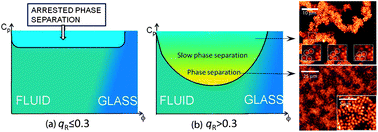Phase separation dynamics in colloid–polymer mixtures: the effect of interaction range
Abstract
Colloid–

* Corresponding authors
a
School of Chemistry, University of Bristol, Bristol BS8 1TS, UK
E-mail:
Isla.Zhang@bristol.ac.uk
b Centre for Nanoscience and Quantum Information, Tyndall Avenue, Bristol BS8 1FD, UK
c HH Wills Physics Laboratory, University of Bristol, Tyndall Avenue, Bristol BS8 1TL, UK
d Bayer CropScience AG, Monheim am Rhein, Germany
Colloid–

 Please wait while we load your content...
Something went wrong. Try again?
Please wait while we load your content...
Something went wrong. Try again?
I. Zhang, C. P. Royall, M. A. Faers and P. Bartlett, Soft Matter, 2013, 9, 2076 DOI: 10.1039/C2SM27119B
To request permission to reproduce material from this article, please go to the Copyright Clearance Center request page.
If you are an author contributing to an RSC publication, you do not need to request permission provided correct acknowledgement is given.
If you are the author of this article, you do not need to request permission to reproduce figures and diagrams provided correct acknowledgement is given. If you want to reproduce the whole article in a third-party publication (excluding your thesis/dissertation for which permission is not required) please go to the Copyright Clearance Center request page.
Read more about how to correctly acknowledge RSC content.
 Fetching data from CrossRef.
Fetching data from CrossRef.
This may take some time to load.
Loading related content
